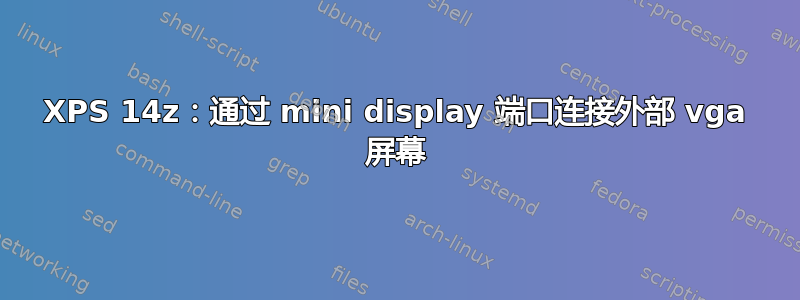
我有一台配备英特尔+英伟达显卡的 XPS 14z,Optimus 技术由 Bumblebee 版本 3 处理。我知道连接到英伟达显卡的 HDMI 端口不应该工作。但是,连接到英特尔显卡的迷你显示端口应该可以工作。
当我在 minidisplay 适配器上连接 vga 电缆时,没有识别到屏幕,也没有识别到图形界面,也没有识别到 xrandr:
Screen 0: minimum 320 x 200, current 1366 x 768, maximum 8192 x 8192
LVDS1 connected 1366x768+0+0 (normal left inverted right x axis y axis) 309mm x 174mm 1366x768 60.0*+ 40.0
1360x768 59.8 60.0
1024x768 60.0
800x600 60.3 56.2
640x480 59.9
VGA1 disconnected (normal left inverted right x axis y axis)
HDMI1 disconnected (normal left inverted right x axis y axis)
DP1 disconnected (normal left inverted right x axis y axis)
我知道有一个与 bumblebee 2.4 兼容的程序这里。 但是它是否已适用于 bumblebee 3?我猜修改 etc/bumblebee/xorg.conf.nvidia 应该可以完成这项工作,但我不敢尝试,因为我不知道我到底在做什么!
感谢您的帮助,
弥敦道
答案1
我已经使用 14z 运行外接显示器。我使用带 VGA 适配器的迷你显示端口。在我看来,您无法使用英特尔卡唤醒它。我使用大黄蜂。在以前的版本中存在一些 EDID 问题,所以我只能管理 640x480。今天我也有更高的分辨率。尝试唤醒 HDMI 会杀死我的系统(它停止响应)。
主要线索有:
该显示器名为DFP-1
两个屏幕共用的鼠标存在问题。
在屏幕部分使用“选项“FlatPanelProperties”“Scaling = Native””。
Bumblebee 使用显示器 :8 启动第二个 X 服务器。因此,请运行例如“DISPLAY=:8 optirun glxspheres”来测试显示器。这意味着您可能需要为显示器使用单独的窗口管理器,并且可能必须提供或共享鼠标和键盘。
(1) 默认情况下,系统会尝试使用 DFP-0,但图片却无处显示。我猜它应该负责 HDMI 端口,但我没能按照所述运行它。
(2) 我对“鼠标问题”的解决方案是在显示器“:8”上使用“void mouse”,然后使用 VNC 连接到它。这样,我的主笔记本电脑屏幕上就会出现一个小窗口,显示显示器上的内容。
(3) Nvidia 试图在显示器上强制使用 1920x1200 等高分辨率,导致较小的显示器显示“错误频率”消息。一种解决方案是运行 nvidia-settings,转到“GPU 0 > DFP-1”部分并取消标记“强制全 GPU 缩放”。可能还需要设置另一个频率。问题是如果显示器显示“错误频率”消息,如何在其上运行 nvidia-settings。另一个解决方案是屏幕部分中的“选项“FlatPanelProperties”“缩放 = 本机””。
我希望这个简短的描述能帮助您运行外部显示器。一些附加信息。我的系统是 Ubuntu 10.04.4 LTS。/etc/bumblebee/xorg.conf.nvidia 内容是:
Section "DRI"
Mode 0666
EndSection
Section "ServerLayout"
Identifier "Layout0"
Option "AutoAddDevices" "false"
Screen "Screen0"
InputDevice "void-mouse"
Option "Xinerama" "0"
EndSection
Section "Module"
Load "dbe"
Load "extmod"
Load "glx"
Load "record"
Load "freetype"
Load "type1"
EndSection
Section "Files"
ModulePath "/usr/lib/nvidia-current/xorg,/usr/lib/xorg/modules"
EndSection
Section "Device"
Identifier "Device1"
Driver "nvidia"
VendorName "NVIDIA Corporation"
BoardName "GeForce GT 520M"
BusID "01:00:0"
Option "NoLogo" "true"
# Option "UseEDID" "false"
Option "UseEDID" "true"
Option "IgnoreEDID"
# Option "ConnectedMonitor" "DFP"
Option "ConnectedMonitor" "DFP-1"
EndSection
Section "Screen"
Identifier "Screen0"
Device "Device1"
DefaultDepth 24
# Monitor "CRT"
Monitor "DFP-1"
Option "TwinView" "0"
Option "metamodes" "1024x768_70 +0+0; 1024x768 +0+0; 800x600 +0+0; 1024x768_85 +0+0"
Option "FlatPanelProperties" "Scaling = Native"
SubSection "Display"
# Virtual 1366 768
# Virtual 1024 768
Depth 24
# Modes "640x480"
# Modes "800x600"
# Modes "1024x768" "800x600"
Modes "1920x1200" "1920x1080" "1680x1050" "1600x1200" "1440x900" "1280x1024" "1366x768" "1360x768" "1280x800" "1024x768" "800x600" "640x480"
EndSubSection
EndSection
Section "Extensions"
Option "Composite" "Enable"
EndSection
Section "Monitor"
Identifier "DFP-1"
VendorName "Unknown"
ModelName "Unknown"
# HorizSync 28.0 - 73.0
HorizSync 31.0 - 82.0
# VertRefresh 43.0 - 72.0
VertRefresh 48.0 - 85.0
Option "DPMS"
Modeline "1920x1200" 193.25 1920 2056 2256 2592 1200 1203 1209 1245 -hsync +vsync
Modeline "1920x1080" 173.00 1920 2048 2248 2576 1080 1083 1088 1120 -hsync +vsync
Modeline "1680x1050" 146.25 1680 1784 1960 2240 1050 1053 1059 1089 -hsync +vsync
Modeline "1600x1200" 161.00 1600 1712 1880 2160 1200 1203 1207 1245 -hsync +vsync
Modeline "1440x900" 106.50 1440 1528 1672 1904 900 903 909 934 -hsync +vsync
Modeline "1366x768" 85.25 1366 1440 1576 1784 768 771 781 798 -hsync +vsync
Modeline "1280x800" 83.50 1280 1352 1480 1680 800 803 809 831 -hsync +vsync
Modeline "1280x1024" 109.00 1280 1368 1496 1712 1024 1027 1034 1063 -hsync +vsync
# Linia wygenerowana przez nvidia-settings
ModeLine "1024x768" 94.500 1024 1072 1168 1376 768 769 772 808 +hsync +vsync
EndSection
Section "InputDevice"
Identifier "void-mouse"
Driver "void"
EndSection


